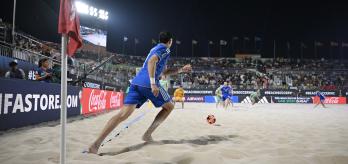When the world’s best defenders can add to the attacking momentum of their team in the offensive phase, it can be game-changing. At FIFA Beach Soccer World Cup UAE 2024™ we saw some outstanding defending, but it was their ability to transition from last-man defensive duties to key attacking responsibilities, both in build-up and following possession regains, that caught the eyes of our Technical Study Group.
Ex-Italy defender Matteo Marrucci was particularly impressed by the versatility of the best defenders at this tournament:
“For the top three teams in this competition, Brazil, Italy and Iran, it is no coincidence that they have defenders that make key contributions to their teams both in and out of possession. It is vital that defenders are excellent in the defensive phase, but when they can transition the ball to attack quickly or can contribute to their team’s attacking phase by exploiting space or creating numerical overloads in the final third, they become a key player. Years ago, it was enough for defenders to just defend, but the best teams in the world have defenders who can attack, and we saw many great examples in this tournament. This is an important evolution in beach soccer.”
It was one of Marrucci’s successors in the Azzurri defence, Josep Jr Gentelin (5), who best encapsulated this ability, and his outstanding performances in both attack and defence saw him selected by the TSG as the adidas Golden Ball winner. Having undergone surgery on an ACL injury in July 2023, he made a remarkable recovery and was on court for a total 158 minutes and two seconds – considerably more than any other outfield player in this competition. He scored four goals and provided three assists on Italy’s journey to the final.
Brazil defender, Filipe (5) also made notable attacking contributions, providing four assists in the competition. In the clips below, we see examples of how the last defender becomes the prime attacker, thus disturbing the opposition’s defensive structures.
Josep Jr makes an attacking run in a 1-3-1
In Italy’s opening group stage match against USA, Josep Jr went from being the deepest player in his team’s build-up phase to scoring, all as a result of making a line-breaking attacking run.
As Dejan Stankovic explains, “Clip 1 below is a perfect example of a defender becoming the key attacker. Before Josep Jr even receives the first pass in the build-up from Marco Giordani (11) we can see he is already preparing to make the attacking run. USA are pressing in a 1-2-1 so there is space available. Josep is looking forward and sees the space he is going to penetrate.
“As soon as receives the ball and plays forward, his run is made with great intent, and he does not even break his stride as he receives the ball in behind the USA defensive line. It is an excellent example of a defender becoming the key attacker and it all comes from his ability to read the game and see the space before receiving that first pass. This looked like something Italy had worked on prior to the game.”
Reza Amiri makes a central attacking run in a 1-2-2
With their game against Spain delicately poised at 5-5 in extra-time, Iran defender Reza Amiri (3) scored an outstanding goal. He started the move as the last defender, and finished it with a spectacular bicycle kick.
Matteo Marrucci ranked his effort as one one of the goals of the tournament:
“This is an amazing goal”, he said. “At the start of this clip, we see how Amiri is the last man in Iran’s 1-2-2 set-up. Spain are man to man in their defensive set-up and when Amiri plays the ball back to his goalkeeper, he immediately makes an attacking run which leaves space in front of the goalkeeper. This gives his Spanish marker Domingo Cabrera (7) a decision to make, and because he chooses to press the goalkeeper, it leaves Amiri free in space for a bicycle kick. If one of Spain’s deeper defenders comes out, there will be a 2v1 in Iran’s favour in the final third, so this attacking run by Amiri caused problematic decisions for Spain’s defenders. It was a very clever movement and came at a crucial time in the game.”
Catarino (BRA) exploits space in the wide area
Against Oman, Brazil defender Catarino (4) scored a wonderful volley after running from the deepest outfield position to find space out wide. TSG expert Dejan Stankovic was struck by the way Catarino’s run disrupted the opposition defence:
“This is another variation of the types of runs defenders are making from the last-man position,” Stankovic said. In this clip, Catarino receives the ball from his goalkeeper in space and draws the nearest defender out. As soon as he plays back to his goalkeeper, he exploits the space in the wide area with his run into the final third before finishing the move with a first-time volley from a tight angle. It is another great example of the disruption these types of attacking runs can cause for opposition defences.”
Ozu shoots from distance
In our next example, we see a long-range goal from Japan defender Ozu Moreira (10), who is left unmarked and given time and space to tee up a blistering strike. As Marrucci points out, a player of Ozu’s quality should not be left unattended when in possession of the ball:
“Ozu is one of the best technical players in the world and he can hurt teams from anywhere on the pitch. It is a big risk to leave him with the ball and under no pressure. In this example we see how the last man, left with time and space, can also punish the opposition. It is always important to remember the players you are playing against in these situations.”
Ninou Diatta (SEN) - The quick transition to attack
In this final clip, Senegal defender Diatta (2) quickly transitions from defensive duties to initiating a fast attack which results in a goal. Speed is of the essence in this move, as Dejan Stankovic explains:
“This is very difficult to stop because of the speed of the transition. We see at the start how he is doing his defensive work, shepherding the ball back to his goalkeeper while under pressure from Japan’s Miyama (2). Immediately, he makes an attacking run, getting away from his opponent and into space. The goalkeeper sees the runs and makes a great distribution into the space in front of Diatta, who scores on the second attempt.
SUMMARY
Defenders who can bring an attacking impetus to their team can change games single-handed, even on the biggest of stages. As we saw at FIFA Beach Soccer World Cup 2024, the world’s best defenders have added this dimension to their game and demonstrated their ability to transition from the last-man to the key attacker.
Moreover, penetrative runs from deep give opposition defenders difficult decisions to make and can exploit space and create numerical overloads. If this World Cup proved anything, perhaps it is that the world's best players now contribute significantly to their teams both in the defensive and offensive phases, regardless of the position they play.



















